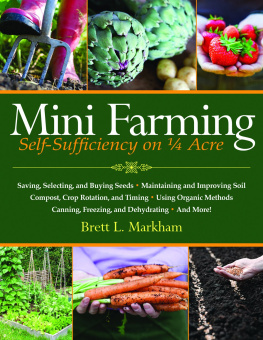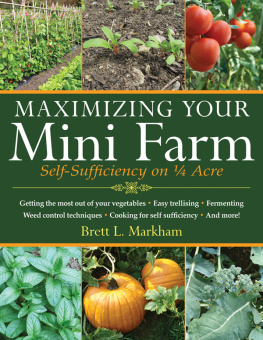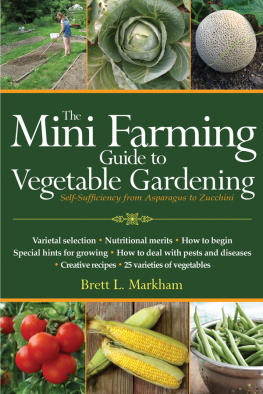The Mini FARMING
Guide to Fermenting

The Mini FARMING
Guide to Fermenting
Self-Sufficiency from Beer and Cheese to Wine and Vinegar
Brett L. Markham

Skyhorse Publishing
Copyright 2012 by Brett L. Markham
All Rights Reserved. No part of this book may be reproduced in any manner without the express written consent of the publisher, except in the case of brief excerpts in critical reviews or articles. All inquiries should be addressed to Skyhorse Publishing, 307 West 36th Street, 11th Floor, New York, NY 10018.
Skyhorse Publishing books may be purchased in bulk at special discounts for sales promotion, corporate gifts, fund-raising, or educational purposes. Special editions can also be created to specifications. For details, contact the Special Sales Department, Skyhorse Publishing, 307 West 36th Street, 11th Floor, New York, NY 10018 or info@skyhorsepublishing.com.
Skyhorse and Skyhorse Publishing are registered trademarks of Skyhorse Publishing, Inc., a Delaware corporation.
www.skyhorsepublishing.com
10 9 8 7 6 5 4 3 2 1
Library of Congress Cataloging-in-Publication Data is available on file.
ISBN: 978-1-61608-613-8
Printed in China
Contents
Acknowledgments
This book draws on a lot of chemistry knowledge. Though I had chemistry instructors in college, the groundwork was laid much earlier by my fathers encouragement in providing me chemistry materials as a child even after I accidentally gassed myself. Two teachers who were very inspiring to my pursuit of science were Mr. Booth, my eighth grade Physical Science teacher who provided demonstrations of exploding sodium (nothing entices a boy more than things that go boom!), and Mrs. Firestone, my teacher for Chemistry I & II in high school, whose love and zeal for the subject was infectious.
A book is sort of like sausage. You see the finished product but you dont necessarily notice everything that went into it. The primary ingredient in a book is time. When you already work a full-time job, that time comes at the expense of other people in your life. I would like to explicitly thank my wife Francine for her editorial assistance and my daughter Hannah for her help with pictures. I also appreciate the patient indulgence of my family and many friends who endured a long leave of absence so I could write books I felt would be helpful.
There were also a lot of experiments along the way. Id like to thank many people I value across the country for their support and for often sampling my concoctions and giving their honest opinions, including my mother-in-law, co-workers at BELD and friends across the country. I kept telling them if they drank enough of my wine it would start to taste good. Eventually ... it did.
PART I
Introductory Considerations

Though it may be hard to imagine, it is only in comparatively recent times that humans have had access to technology such as freezers, refrigerators, and canning as a means of preserving food. Even today, many parts of the world have scant access to electricity or modern devices. In these areas, as well as in historic times in locales where the availability of food has varied with the seasons, preservation of food for lean times was and still is extremely important. Likewise, in many periods of history, the knowledge of sanitation has been poor, and the water supply a source of illness. Hence, fermented beverages free of disease-causing bacteria and protozoans were more commonly consumed than water.
Fermentation is one of the oldest means of food preservation known to humanity, perhaps surpassed in age only by dehydration. The underlying idea of using fermentation to preserve food is straightforward: Some element of the food that would ordinarily support rotting is converted into something that retards rotting. In this fashion, the shelf-life of the food is increased while retaining many of its beneficial nutritional qualities.
In the case of wine or beer, sugars that would support many disease organisms are converted into alcohol, which is a potent germicide. In the instance of yogurt and similar soft cheeses, the sugar lactose is converted to lactic acid, which lowers the pH of the milk sufficiently that many rotting organisms cannot survive. Vinegar is a further oxygenation of alcohol that is both directly toxic to many microbes but, like lactic acid, it also lowers the pH to such a level as to create an environment hostile to the survival of disease organisms.
Sometimes fermentation is simply used to make something that is more tasty or portable. Certainly, cheese is more portable than milk, and bread is more tasty than cracked wheat kernels.
Fermented foods have progressed well beyond their start as a means of food preservation, and are now a cornerstone of the human diet. Fermented foods are not just made to preserve their ingredients: they are culinary elements in their own right. I sincerely doubt that most people think of wine as a means of preserving the antioxidants of grape juice or of cheese as a means of preserving the proteins in milk for long shelf life. Instead, these are produced and consumed as dietary constituents that are, in many cases, preferred over their initial ingredients.
Fermented foods cost money. Because of the additional work required to create them, they usually cost considerably more than their raw ingredients would cost. Furthermore, some fermented foods have costs added in the form of sin taxes that make them even more expensive. Sometimes, it is difficult if not impossible to even buy certain fermented foods at all, such as wine made from organic apples and local honey. I have found local wines that include honey, but at $32/ bottle they are cost-prohibitive. Making your own will give an excellent product at a much more reasonable price.
When I set out to write this book, I was already broadly familiar with the many books in print addressing these subjects. Some of them are truly excellent and charmingly written. I treasure them and enjoy them, and hope you will too. But almost all of these books are predominantly dedicated to recipes. They provide a bit of explanation, but their primary thrust is showing you how to duplicate what someone else has already done. Though this can be useful, it isnt true self-sufficiency. What if someone gives you a bushel of starfruit that you want to turn into wine but you cant find a recipe? How do you make your own malt for beer?
Many other books are essentially chemistry books. As a man with his own chemistry lab, I can really appreciate a good chemistry book! The problem is that most people havent taken chemistry since high school and are somewhat stymied by the chemical equations and their meanings. A discussion of pH in terms of logarithmic concentration of H+ ions may be entirely factual, but also perfectly useless. Even though these chemistry books definitely contain all of the information needed to adapt recipes, translating them into something actionable by a non-chemist in the real world can be challenging.
In my earlier books, Mini Farming: Self-Sufficiency on Acre and Maximizing Your Mini Farm, I endeavored to convey the underlying principles and reasoning for the methods rather than just instructions. That is my objective with this book as well. I want to provide sufficient background in the underlying chemistry to enable you to be flexible and adaptive, but concentrate on practical nuts-and-bolts skills needed to convey self-sufficiency quickly.
















